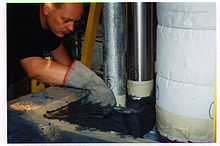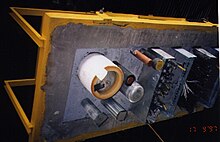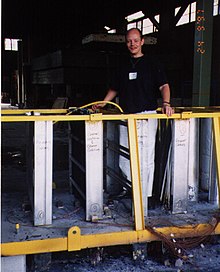Fire testing
A fire test (including fire test ) is used to prove the fire resistance period of a component .
Many tests are carried out by official laboratories. However, some manufacturers of fire protection products also have their own stoves for research and development purposes . There are many types of fire tests for systems and their components. For example, there are material tests only for intumescent layers to prove their function within many systems. Some tests are small and some are very large, with test specimen areas of 9 m². In some countries, the extinguishing water test is then carried out. The extinguishing water test is not intended to simulate the fire brigade , but is intended to add a quantum of mechanical stress / reality to the test. The 30 PSI required for North America is measured at the nozzle. In Europe , extinguishing water tests are not a requirement.
Sealing in an F180 concrete ceiling
The following pictures show a typical fire test of a foreclosure in a F180 concrete ceiling .
This fire test corresponds to the Canadian standard ULC-S115 and achieved fire resistance times between 0 and 180 minutes, for various systems that were tested as a whole. An extinguishing water test, which z. B. is a requirement in the USA , was only partially passed. The test took place at Underwriters' Laboratories of Canada (subsidiary of Underwriters Laboratories ), in Scarborough, Ontario , Canada . Z. as evidence for building inspectorate approvals in the NAFTA area.
Coreslab concrete frame is being prepared.
Pipes and cable openings are hung up.
Fire protection mortar is pumped into the opening.
Material testing on the fire protection mortar .
Furnace for use for fire tests. A simple metal box, insulated with ceramic fiber and fitted with thermocouples protected by tubes . Below you can see the perforated gas pipes through which the fuel comes into the combustion chamber.
The fire test is in progress. You not only observe the combustion chamber temperature, but also the temperature on the bulkhead and on the openings themselves. You also listen to acoustic signals, such as B. the crackling of hot cable jackets, which can cause the entire test to fail if a fire is ignited.
30 PSI exam begins.
The extinguishing water test was largely passed - with the exception of two breakthroughs, which were sealed with rock wool and silicone rubber . Since too much heat came through the adjacent metal, the silicone let go during the test and the extinguishing water could penetrate through there. This disqualifies the system from being used in the US , but not Canada .
Fire test according to Canadian standards
Structure of the test body
Construction of a test body for a fire test according to ULC S-115, the Canadian standard for fire resistance of bulkheads . The test specimen consists of a 5 '× 9' × 4 '' concrete ceiling (approx. 1.5 m × 2.3 m × 10 cm) with a large hole and many mechanical and electrical openings. In the picture, a fire protection mortar is being applied to seal the hole with the test material.
Assembly of the test body
The finished test specimen is transported to the furnace by a crane and placed there on a ceramic fiber seal. Here you can see the bottom. The Canadian test standard ULC S-115 stipulates that the openings must reach 12 ″ (30 cm) into the furnace in order to absorb the heat that loads the bulkhead from the inside when it is passed through . In Germany , DIN 4102 stipulates a length of 1 m, which is more realistic. North American wall ovens are not deep enough for this.
Flaming
The finished test specimen was placed on the open oven. A seal made of ceramic fibers lies between the test specimen and the furnace edge. Perforated gas pipes run below. Thermocouples in the furnace itself measure the temperature in the combustion chamber. By regulating the gas supply, you can maintain the time / temperature curves within the permissible tolerance. This can be regulated manually, but nowadays gas regulation is largely electronic. Thermocouples are also placed on the side facing away from the fire, as the time span in which either an average temperature increase of 140 ° C or a single increase of 180 ° C above the initial temperature has been reached is decisive for quantifying the fire resistance period. At the beginning you open the gas valves and in this case you plug them in manually.
evaluation
After the flame treatment has been successfully completed, the test specimen is removed from the furnace. Test reports record all observations from both sides of the test specimen as well as all temperatures on the test specimen and in the oven. In the case of flammable breakthroughs such as cables, it is not uncommon to see residual fires even after two hours of exposure to fire. But the fire must not go through the partitioning or the breakthrough. The temperature increase on the side facing away from the fire must also remain so low that there is no risk of causing a new fire on the cold side. In Canada it is therefore mandatory to measure the temperature on the seal, 25 mm from the penetration, and on the penetration, 25 mm from the penetration.
Extinguishing water test
After the flame is applied, the extinguishing water test comes. The duration and the pressure depend on the flame time and the test body area.
Examination certificate
The test is considered to have been passed if neither fire nor too much heat came through the test body for the intended flame exposure time. The time periods are quantified for each breakthrough and specified in the fire resistance class. The building authority approval resulting from the test certificate is considered to be in the public domain or public knowledge.
Rework
Observations from both sides of the test body also follow when the test body has returned to normal room temperature. It is also common to destroy the specimen in order to learn from the inside. This applies to the manufacturer's research and development work, but also to the laboratory, to ensure that no cheating was carried out while the test specimen was being set up.
Conditions of the test procedure
As a rule, almost identical curves are used internationally, which for buildings are based on measurements of burning logs. According to DIN 4102 which is the standard temperature-time curve defined. The hydrocarbon curve is used for outdoor applications in refineries and chemical plants . In the tunnel area too, various hydrocarbon curves have been used, particularly since the “Eureka” project. The fire in the tunnel, especially in the case of an oil or fuel fire, makes countermeasures difficult, especially because the heat cannot escape quickly. In the open air, such as the refinery, it goes upstairs. The tunnel, however, forms a kind of microclimate, which is the reason for the particularly hot curves.
In conventional building applications, however, there are only minor international differences between the curves.
A big difference between North America and the other industrialized countries is that the thermocouples are hidden inside the furnace in tubes, which slows down the measurement and thus makes the North American test a bit more conservative than ISO . However, the ISO curve is largely a bit hotter. You can also use the extinguishing water test in North America, which is otherwise unusual outside of NAFTA . Only the US Navy requires a 90 PSI test for components on their ships. Germany requires an impact test on fire walls , but this must be carried out from the side facing away from the fire.
If you want to sell fire protection products internationally, you have to finance and carry out a variety of tests, because many countries do not recognize tests from foreign countries. Although the exams are very similar, the legislation in different countries is different. Accreditations of institutes between different countries are also not tangible in legal disputes.
Time / temperature curves (ZTk) for the course of fire tests for components:
European and North American ZTk. The American hydrocarbon curve and the wood-based curves are compared .
- * Tolerances of this kind are typical of all international fire testing standards. If you go too far below the tolerance, it is sometimes permissible to let a test run longer to compensate for the lack of heat. Excessive smoke development in the fire chamber can lead to this, for example when testing with a large number of cables, silicone foam or plastic pipes .
literature
- Gerd Birthig: Structural fire protection in existing buildings. Volume 1, 3rd edition, Beuth Verlag, Berlin 2014, ISBN 978-3-410-24434-9 .
See also
Web links
- Fire tests and certifications (accessed February 28, 2020)
- Fire standards (accessed February 28, 2020)
- Fire behavior of the interiors of coaches (accessed on February 28, 2020)
- Overview of fire tests (accessed on February 28, 2020)
- Industrial building guidelines, DIN 18234, FM-Global (accessed on February 28, 2020)




























